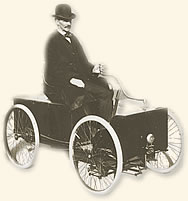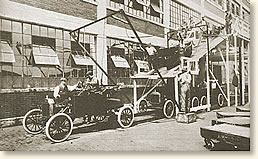|
Henry Ford Changes the World, 1908
At the beginning of the 20th century the automobile was a plaything for the rich. Most models were complicated machines that required a chauffer conversant with its individual mechanical nuances to drive it. Henry Ford was determined to build a simple, reliable and affordable car; a car the average American worker could afford. Out of this determination came the Model T and the assembly line - two innovations that revolutionized American society and molded the world we live in today.
Henry Ford did not invent the car; he produced an automobile that was within the economic reach of the average American. While other manufacturers were content to target a market of the well-to-do, Ford developed a design and a method of manufacture that

Henry Ford and his first car
the Quadricycle, which he
built in 1896 |
steadily reduced the cost of the Model T. Instead of pocketing the profits; Ford lowered the price of his car. As a result, Ford Motors sold more cars and steadily increased its earnings - transforming the automobile from a luxury toy to a mainstay of American society.
The Model T made its debut in 1908 with a purchase price of $825.00. Over ten thousand were sold in its first year, establishing a new record. Four years later the price dropped to $575.00 and sales soared. By 1914, Ford could claim a 48% share of the automobile market.
Central to Ford's ability to produce an affordable car was the development of the assembly line that increased the efficiency of manufacture and decreased its cost. Ford did not conceive the concept, he perfected it. Prior to the introduction of the assembly line, cars were individually crafted by teams of skilled workmen - a slow and expensive procedure. The assembly line reversed the process of automobile manufacture. Instead of workers going to the car, the car came to the worker who performed the same task of assembly over and over again. With the introduction and perfection of the process, Ford was able to reduce the assembly time of a Model T from twelve and a half hours to less than six hours.
The Ford Motor Company manufactured its first car - the Model A - in 1903. By 1906, the Model N was in production but Ford had not yet achieved his goal of producing a simple, affordable car. He would accomplish this with the Model T. Charles Sorensen - who had joined Henry Ford two years earlier - describes how Ford had him set up a secret room where design of the new car would be carried out:
"Early one morning in the winter of 1906-7, Henry Ford dropped in at the pattern department of the Piquette Avenue plant to see me. 'Come with me, Charlie,' he said, 'I want to show you something.'
I followed him to the third floor and its north end, which was not fully occupied for assembly work. He looked about and said, 'Charlie, I'd like to have a room finished off right here in this space. Put up a wall with a door in big enough to run a car in and out. Get a good lock for the door, and when you're ready, we'll have Joe Galamb come up in here. We're going to start a completely new job.'
The room he had in mind became the maternity ward for Model T.
It took only a few days to block off the little room on the third floor back
of the Piquette Avenue plant and to set up a few simple power tools and Joe
Galamb's two blackboards. The blackboards were a good idea. They gave a king-sized
drawing which, when all initial refinements had been made, could be photographed
for two purposes: as a protection against patent suits attempting to prove
prior claim to originality and as a substitute for blueprints. A little more
than a year later Model T, the product of that cluttered little room, was announced
to the world. But another half year passed before the first Model T was ready
for what had already become a clamorous market...
The summer before, Mr. Ford told me to block off the experimental room for Joe Galamb, a momentous event occurred which would affect the entire automotive industry. The first heat of vanadium steel in the country was poured at the United Steel Company's plant in Canton, Ohio.
Early that year we had several visits from J. Kent Smith, a noted English metallurgist
from a country which had been in the forefront of steel development...

The 1908 Model T. Two forward
gears, a 20 horsepower engine
and no driver doors.
They sold like hot cakes |
Ford, Wills, and I listened to him and examined his data. We had already read about this English vanadium steel. It had a tensile strength nearly three times that of steels we were using, but we'd never seen it. Smith demonstrated its toughness and showed that despite its strength it could be machined more easily than plain steel. Immediately Mr. Ford sensed the great possibilities of this shock-resisting steel. 'Charlie,' he said to me after Smith left, 'this means entirely new design requirements, and we can get a better, lighter, and cheaper car as a result of it.'
It was the great common sense that Mr. Ford could apply to new ideas and his ability to simplify seemingly complicated problems that made him the pioneer he was. This demonstration of vanadium steel was the deciding point for him to begin the experimental work that resulted in Model T...
Actually it took four years and more to develop Model T. Previous models were the guinea pigs, one might say, for experimentation and development of a car which would realize Henry Ford's dream of a car which anyone could afford to buy, which anyone could drive anywhere, and which almost anyone could keep in repair. Many of the world's greatest mechanical discoveries were accidents in the course of other experimentation. Not so Model T, which ushered in the motor transport age and set off a chain reaction of machine production now known as automation. All our experimentation at Ford in the early days was toward a fixed and, then wildly fantastic goal.
By March, 1908, we were ready to announce Model T, but not to produce it, On October 1 of that year the first car was introduced to the public. From Joe Galamb's little room on the third floor had come a revolutionary vehicle. In the next eighteen years, out of Piquette Avenue, Highland Park, River Rouge, and from assembly plants all over the United States came 15,000,000 more."
A few months later- in July 1908 - Sorensen and a plant foreman spent their days off developing the basics of the Assembly Line:
"What was worked out at Ford was the practice of moving the work from one worker to another until it became a complete unit, then arranging the flow of these units at the right time and the right place to a moving final assembly line from which came a finished product. Regardless of earlier uses of some of these principles, the direct line of succession of mass production and its intensification into automation stems directly from what we worked out at Ford Motor Company between 1908 and 1913...
As may be imagined, the job of putting the car together was a simpler one than handling the materials that had to be brought to

The old fashioned way - limousines are
assembled at individual stations
by a Pittsburg manufacturer, 1912 |
it. Charlie Lewis, the youngest and most aggressive of our assembly foremen, and I tackled this problem. We gradually worked it out by bringing up only what we termed the fast-moving materials. The main bulky parts, like engines and axles, needed a lot of room. To give them that space, we left the smaller, more compact, light-handling material in a storage building on the northwest comer of the grounds. Then we arranged with the stock department to bring up at regular hours such divisions of material as we had marked out and packaged.
This simplification of handling cleaned things up materially. But at best, I did not like it. It was then that the idea occurred to me that assembly would be easier, simpler, and faster if we moved the chassis along, beginning at one end of the plant with a frame and adding the axles and the wheels; then moving it past the stockroom, instead of moving the stockroom to the chassis. I had Lewis arrange the materials on the floor so that what was needed at the start of assembly would be at that end of the building and the other parts would be along the line as we moved the chassis along. We spent every Sunday during July planning this. Then one Sunday morning, after the stock was laid out in this fashion, Lewis and I and a couple of helpers put together the first car, I'm sure, that was ever built on a moving line.
We did this simply by putting the frame on skids, hitching a towrope to the front end and pulling the frame along until axles and wheels were put on. Then we rolled the chassis along in notches to prove what could be done. While demonstrating this moving line, we worked on some of the subassemblies, such as completing a radiator with all its hose fittings so that we could place it very quickly on the chassis. We also did this with the dash and mounted the steering gear and the spark coil."
The basics of the Assembly Line had been established but it would take another five years for the concept to be implemented. Implementation would await construction of the new Highland Park plant which was purpose-built to incorporate the assembly line. The process began at the top floor of the four-story building where the engine was assembled and progressed level by level to the ground floor where the body was attached to the chassis.

End of the Line. The Model T's body is joined
to its chassis at the Highland Park plant |
"By August, 1913, all links in the chain of moving assembly lines were complete except the last and most spectacular one - the one we had first experimented with one Sunday morning just five years before. Again a towrope was hitched to a chassis, this time pulled by a capstan. Each part was attached to the moving chassis in order, from axles at the beginning to bodies at the end of the line. Some parts took longer to attach than others; so, to keep an even pull on the towrope, there must be differently spaced intervals between delivery of the parts along the line. This called for patient timing and rearrangement until the flow of parts and the speed and intervals along the assembly line meshed into a perfectly synchronized operation throughout all stages of production. Before the end of the year a power-driven assembly line was in operation, and New Year's saw three more installed. Ford mass production and a new era in industrial history had begun"
References:
Charles Sorensen's account can be found in: Sorensen, Charles, E., My Forty Years with Ford (1956); Banum, Russ, The Ford Century (2002); Brinkley, Douglas, Wheels for the world: Henry Ford, his company, and a century of progress, 1903-2003 (2003).
How To Cite This Article:
"Henry Ford Changes the World, 1908," EyeWitness to History www.eyewitnesstohistory.com (2005).
|






